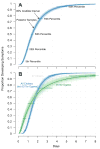The incubation period of cholera: a systematic review
- PMID: 23201968
- PMCID: PMC3677557
- DOI: 10.1016/j.jinf.2012.11.013
The incubation period of cholera: a systematic review
Abstract
Objectives: Recent large cholera outbreaks highlight the need for improved understanding of the pathogenesis and epidemiology of cholera. The incubation period of cholera has important implications for clinical and public health decision-making, yet statements of the incubation period of cholera are often imprecise. Here we characterize the distribution of cholera's incubation period.
Methods: We conducted a systematic review of the literature for statements of the incubation period of cholera and data that might aid in its estimation. We extracted individual-level data, parametrically estimated the distribution of toxigenic cholera's incubation period, and evaluated evidence for differences between strains.
Results: The incubation period did not differ by a clinically significant margin between strains (except O1 El Tor Ogawa). We estimate the median incubation period of toxigenic cholera to be 1.4 days (95% CI, 1.3-1.6). Five percent of cholera cases will develop symptoms by 0.5 days (95% CI 0.4-0.5), and 95% by 4.4 days (95% CI 3.9-5.0) after infection.
Conclusions: We recommend that cholera investigations use a recall period of at least five days to capture relevant exposures; significantly longer than recent risk factor studies from the Haitian epidemic. This characterization of cholera's incubation period can help improve clinical and public health practice and advance epidemiologic research.
Copyright © 2012 The British Infection Association. Published by Elsevier Ltd. All rights reserved.
Figures


Comment in
-
Cholera: resurgence of fatal yet preventable disease.BMJ. 2023 Aug 14;382:1831. doi: 10.1136/bmj.p1831. BMJ. 2023. PMID: 37580086 No abstract available.
Similar articles
-
Signs and symptoms to determine if a patient presenting in primary care or hospital outpatient settings has COVID-19.Cochrane Database Syst Rev. 2022 May 20;5(5):CD013665. doi: 10.1002/14651858.CD013665.pub3. Cochrane Database Syst Rev. 2022. PMID: 35593186 Free PMC article.
-
Systemic pharmacological treatments for chronic plaque psoriasis: a network meta-analysis.Cochrane Database Syst Rev. 2021 Apr 19;4(4):CD011535. doi: 10.1002/14651858.CD011535.pub4. Cochrane Database Syst Rev. 2021. Update in: Cochrane Database Syst Rev. 2022 May 23;5:CD011535. doi: 10.1002/14651858.CD011535.pub5. PMID: 33871055 Free PMC article. Updated.
-
Immunogenicity and seroefficacy of pneumococcal conjugate vaccines: a systematic review and network meta-analysis.Health Technol Assess. 2024 Jul;28(34):1-109. doi: 10.3310/YWHA3079. Health Technol Assess. 2024. PMID: 39046101 Free PMC article.
-
Factors that impact on the use of mechanical ventilation weaning protocols in critically ill adults and children: a qualitative evidence-synthesis.Cochrane Database Syst Rev. 2016 Oct 4;10(10):CD011812. doi: 10.1002/14651858.CD011812.pub2. Cochrane Database Syst Rev. 2016. PMID: 27699783 Free PMC article.
-
Incubation period of typhoidal salmonellosis: a systematic review and meta-analysis of outbreaks and experimental studies occurring over the last century.BMC Infect Dis. 2018 Sep 27;18(1):483. doi: 10.1186/s12879-018-3391-3. BMC Infect Dis. 2018. PMID: 30261843 Free PMC article.
Cited by
-
Two cases of cholera O1 in South Batinah, Oman, April 2019: lessons learned.Epidemiol Health. 2019;41:e2019033. doi: 10.4178/epih.e2019033. Epub 2019 Jul 12. Epidemiol Health. 2019. PMID: 31319654 Free PMC article.
-
Outbreak investigation of cholera outbreak in a slum area of urban Wardha, India: An interventional epidemiological study.J Family Med Prim Care. 2019 Mar;8(3):1112-1116. doi: 10.4103/jfmpc.jfmpc_308_18. J Family Med Prim Care. 2019. PMID: 31041259 Free PMC article.
-
Descriptive epidemiology of a cholera outbreak in Kaduna State, Northwest Nigeria, 2014.Pan Afr Med J. 2017 Jul 4;27:172. doi: 10.11604/pamj.2017.27.172.11925. eCollection 2017. Pan Afr Med J. 2017. PMID: 28904700 Free PMC article.
-
Evaluation of the Bruker Biotyper matrix-assisted laser desorption ionization-time of flight mass spectrometry system for identification of blood isolates of Vibrio species.J Clin Microbiol. 2015 May;53(5):1741-4. doi: 10.1128/JCM.00105-15. Epub 2015 Mar 4. J Clin Microbiol. 2015. PMID: 25740773 Free PMC article.
-
Stochastic SIRC epidemic model with time-delay for COVID-19.Adv Differ Equ. 2020;2020(1):502. doi: 10.1186/s13662-020-02964-8. Epub 2020 Sep 18. Adv Differ Equ. 2020. PMID: 32963509 Free PMC article.
References
-
- World Health Organization. Cholera. World Health Organization; 2012. [accessed 09.02.12]. http://www.who.int/mediacentre/factsheets/fs107/en/
Publication types
MeSH terms
Grants and funding
LinkOut - more resources
Full Text Sources
Other Literature Sources
Medical

